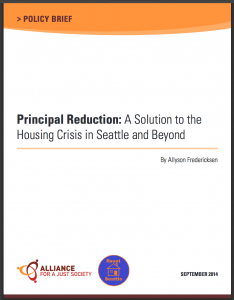Students and graduates throughout the country continue to bear the burden of the high cost of education by taking out student loans. For those in states with high average student debt and lower median incomes, the weight of student loans combined with low incomes can mean a lifetime of debt.
The Alliance for a Just Society has released two new “A Mountain of Debt” reports, one last Thursday in Maine, and another today in Montana. The state-specific reports highlight the difficulty of paying for school and paying off loans after graduation in states with predominantly lower wages. When comparing student debt to median household income, Maine has the 11th highest student debt-to-median income ratio in the country. Montanans fare even worse with the 6th highest ratio.
With half or fewer job openings paying a living wage for a single adult, average student loan debts after college graduation of over $27,000 in Montana and over $29,000 in Maine leave graduates without the means to pay off their loans in a timely matter – if they can afford to make payments at all.
As a single mother with significant student loan debt, Kimberly Hammill of Levant, Maine finds that her loans keep her from financial stability.
“Not only did I go to school to better myself and enter a rewarding career, but I also wanted to improve both my daughter’s and my quality of life. My student loans funded my education, but today they keep me in the same state of economic dependence I was experiencing before school. I still have to rely on social services to get by,” said Hammill.
Adam Bland of Presque Isle, Maine says his student loans keep him from saving for the future and living the life he wants today.
“My loan payments take up a little more than 20 percent of my monthly take home pay,” Bland said. “If I didn’t have to make these payments, I would be investing in a 401K, setting money aside for emergencies, and definitely doing a little bit of traveling, but the high interest payments mean I can’t.”
Jan Siemers of Helena, Montana doesn’t have student debt of her own, but she has seen her grown children struggle with their student debt.
“We want our children to be successful and are often told that a college education is the best path, but today I am witnessing firsthand how the resulting student debt is destroying economic opportunities for young people,” Siemers said.
Graduates like Clementine Lindley in Billings, Montana wonder whether student loans are worth it.
“My experience in college has meant so much to me, and has shaped who I am today,” she said. “Sadly though, I am not sure I would make the same decision if given the chance to go back and do it again. While the experiences were invaluable, the $90,000 price tag has been extremely difficult to handle.”
States need to reinvest in higher education, explore innovative solutions to address rising tuition and fees, allow students and graduates to refinance their loans, and increase wages so that graduates can actually afford to pay off their loans. Students and graduates in Maine and Montana deserve to have their hard work pay off, without seeing their dreams crushed by student debt.




